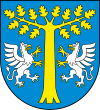SS-Truppenübungsplatz Heidelager
| SS-Truppenübungsplatz Heidelager | |
|---|---|
|
SS-officer training camp Concentration camp | |
|
| |
| Coordinates | 50°8′25″N 21°29′20″E / 50.14028°N 21.48889°ECoordinates: 50°8′25″N 21°29′20″E / 50.14028°N 21.48889°E |
| Operated by | Schutzstaffel (SS) |
| Commandant | Oberführer-SS Bernhardt Voss |
| Original use | Slave labour, POW internment |
| Operational | January 1940 – August 1944 |
| Inmates | Jews, Poles, Russians |
| Killed | 15,000 total: 7,000 Jews, 5,000 Soviets, 3,000 Polish[1][2] |
| Liberated by |
|
SS-Truppenübungsplatz Heidelager was a World War II SS military complex and Nazi concentration camp in Pustków and Pustków Osiedle, Poland.[1][3] The Nazi German army training facility called HL-Heidelager was for the Ukrainian 14th Waffen SS Division "Galician",[3] as well as collaborationist military units, including those from Estonia.[4] The training at this facility included killing operations inside the concentration camps – most notably at the nearby Pustków and Szebnie camps – and Jewish ghettos in the vicinity of Pustków and in the town itself.[5][6] The military area was situated in the triangle of the Wisła and San rivers, dominated by large forest areas. The centre of the 'Heidelager' was at Blizna, the location of the secret Nazi V-2 missile launch site, which was built and staffed by prisoners from the concentration camp at Pustków.
History
Originally, the Nazis planned to erect a large SS training camp near Pustków with barracks, warehouses, and buildings for the intelligence services. The facility was built on an order from the Reichsführer-SS Heinrich Himmler under provision OKW No. 3032 of 21 December 1939, which allowed for the erection of an SS military training centre in the area eastward of Dębica in Generalgouvernement Polen. The training site was to be built as a barrack camp with four ring roads. It was to be completed on 1 October 1940 for two reinforced infantry regiments. To this end, about a dozen villages near Pustków were evacuated and then razed.[3]
To have sufficient manpower to realize this plan, the Nazis first set up a workers' camp. The camp opened on 26 June 1940 with the arrival the first workers, mostly Jews[2] and imported Belgian prisoners. The conditions were so terrible that most prisoners did not survive the first few months.[7] Over its four-year history, the SS military training centre had several changes of name.[8] In the planning stages, it had been given the name of "Ostpolen" as an SS military training centre from 21 December 1939 to 26 June 1940. With the beginning of the actual construction of the site on 26 June, it was renamed SS "Dębica".[8] From 15 March 1943, the site was designated as SS "Heidelager".[8] The camp had been in use since the autumn of 1941 under the command of Oberführer-SS Werner von Schele.[3][8]
The location was expanded into a prisoner of war camp for Red Army soldiers captured in the Soviet zone of occupied Poland after the implementation of Operation Barbarossa, the first of them arriving in October 1941.[2][9] In the beginning, the POW camp was no more than an enclosed area. The prisoners received minimal or no food, and were reduced to eating grass and roots. There were no barracks, so prisoners had to sleep under the open sky. The lack of shelter killed many prisoners in the severe winter of 1941–42. Many were tortured and mistreated, or in bulk were executed at the foot of what became known as the Góra Śmierci ('Hill of death'), its real name being Królowa Góra.[10] On this hill the dead inmates were cremated in specially built funeral pyres.[10]
In September 1942 came a third camp for Poles in forced labour.[2] The conditions there were no better than at the other two camps. These prisoners were involved in the development and production of the V-1 and V-2 rockets in the nearby missile launch site in Blizna.[2] From 1943 the camp was guarded by units of the 204th Schutzmannschafts Battalion, a battalion consisting of ethnic Ukrainians from the area of Lviv.
The total number of victims in the Pustków camp is unknown. In 1944, the camp was disbanded and the survivors executed. It is estimated that at least 15,000 people died or were killed, including approximately 5,000 Russian prisoner of war, 7,500 Jews, and 2,500 Poles.[1][2] The last commandant of the training base was Totenkopfverbände-Oberführer-SS Bernhardt Voss, until the summer of 1944.[3]

The facility resembled a small city with its own narrow-gauge railway line, some 3,600 men of different nationalities, cinemas, dining halls, dozens of villas, a newsletter, a large camp brothel staffed by female prisoners from the slave labour camp nearby, and regular hunting parties for the high-ranking officers. This is where the Galizien Division came into existence. The range was visited by Reichsführer-SS Heinrich Himmler on 28 September 1943, and abandoned in the summer of 1944 ahead of the Soviet advance.[3]
After the camp was abandoned, the area was still defended by a combat group of the Waffen-SS, under the leadership of a SS storm-troopers. The camp was destroyed by fire during the evacuation of the military training centre.
Because of the crimes committed on the military training ground, criminal charges were filed by Polish individuals to the Nazi war crimes commission.
Modern day
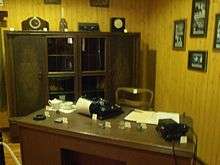
Today the site houses a reconstruction of huts in the camp. Inside the huts there is a museum, comprising original artifacts from the site, including a reconstruction of the camp commandant Oberführer-SS Bernhardt Voss' private office. There are memorials to the dead and the original crematorium on the adjoining Góra Śmierci.
See also
References
Notes
- 1 2 3 "Artilleriezielfeld Blizna" [Blizna (treść tablicy informacyjnej na terenie dawnego poligonu).] (in German). Archived from the original on 29 March 2009.
- 1 2 3 4 5 6 Metz, Kaj. "SS-Truppenübungsplatz Heidelager / Concentration Camp Pustkow". Traces of War.com. Traces of War. Archived from the original on 5 November 2016. Retrieved 5 November 2016.
- 1 2 3 4 5 6 "Historia poligonu Heidelager" [History of Heidelager military training base] (in Polish). Republika.pl. Archived from the original on 18 April 2014. Retrieved 5 November 2016.
- ↑ Terry Goldsworthy (2010). "Valhalla's Warriors" (Google Book preview). A History of the Waffen-SS on the Eastern Front 1941–1945. Dog Ear Publishing. p. 144. ISBN 1-60844-639-5. Retrieved 5 July 2013.
- ↑ Howard Margolian (2000). Unauthorized entry: the truth about Nazi war criminals in Canada, 1946–1956. University of Toronto Press. p. 132. ISBN 0-8020-4277-5. Retrieved 6 July 2013.
- ↑ Jacek Bracik, Józef Twaróg (2003). "Obóz w Szebniach (Camp in Szebnie)" (in Polish). Region Jasielski, nr 3 (39). Archived from the original on 1 February 2010. Retrieved 4 July 2013.
- ↑ "Forgotten Camps – Pustków". jewishgen.org. JewishGen.org. Archived from the original on 14 March 2007. Retrieved 5 November 2016.
- 1 2 3 4 "Truppenübungsplatz der Waffen-SS Dębica "Heidelager"" [SS-Truppenübungsplatz Heidelager]. lexikon-der-wehrmacht.de (in German). Lexikon der Wehrmacht.de. Archived from the original on 5 July 2007. Retrieved 5 November 2016.
- ↑ Schulte, Jan Erik Zwangsarbeit und Vernichtung: Das Wirtschaftsimperium der SS. Oswald Pohl und das SS-Wirtschafts-Verwaltungshauptamt 1933–1945. Mit einem Vorwort von Hans Mommsen. Schöningh, Paderborn u. a. 2001, ISBN 3-506-78245-2 (Zugleich: Bochum, Universität, Dissertation, 1999). (in German)
- 1 2 Staff writer (2013). "Poligon – Blizna". Teren obozu zaglady w Pustkowie (in Polish). Bizna OVH.org. Retrieved 12 August 2013.
Sources
- The initial version of this article is based on a translation of article Kamp Pustków of the Dutch language edition of Wikipedia.
Bibliography
- Stanisław Zabierowski, „Pustków hitlerowskie obozy wyniszczenia w służbie SS” KAW, Rzeszów 1981. (Polish)
Gallery
-
Reconstructed huts
-
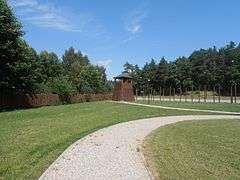
Site of camp
-

Camp watchtower
-
Camp watchtower
-
Huts
-
Cross on Góra Śmierci
-
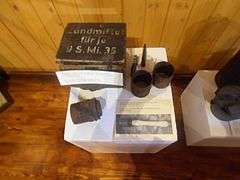
Exhibits in SS-Truppenübungsplatz Heidelager museum
-
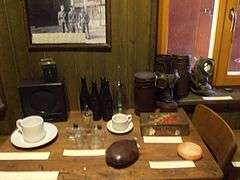
Reconstruction of the camp commandant Bernhardt Voss' private office
-

Prisoners of SS-Truppenübungsplatz Heidelager
-

Photographs of prisoners of SS-Truppenübungsplatz Heidelager
-
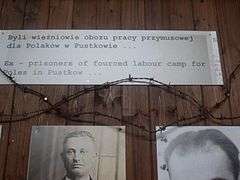
Photographs of prisoners of SS-Truppenübungsplatz Heidelager
-

Crematorium on Góra Śmierci, Pustków
-

Memorial on Góra Śmierci to all who died at the concentration camp
-

Memorial on Góra Śmierci
-
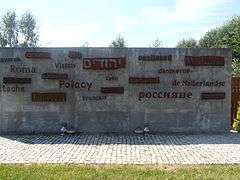
Peace Memorial at SS-Truppenübungsplatz Heidelager
External links
- Werkkamp Pustków (Dutch)
- Pustków (Death Hill, V-missile base and SS military training ground) op www.it.tarnow.pl
- Pustkow op www.jewishvirtuallibrary.org


